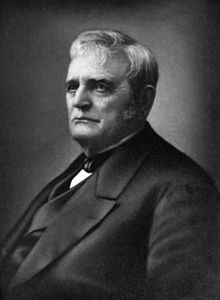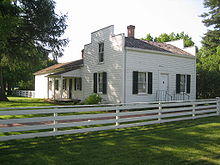- John Deere (inventor)
-
John Deere 
Born February 7, 1804
Rutland, VermontDied May 17, 1886 (aged 82)
Moline, IllinoisNationality American Occupation Inventor Known for Deere & Company,steel plow Spouse Demarias Lamb Deere (Married on January 28, 1827, until Demarias' death in 1865) and Lucenia Lamb Deere (Demarias' sister, Married from 1867 until John's death in 1886) [1] Children Francis Albert (1828-1848), Jeanette (1830-1916), Ellen Sarah (1832-1897), Frances Alma (1834-1851), Charles (1836-1907), Emma Charlotte (1840-1911), Hiram Alvin (1842-1844), Alice Marie (1844-1900), Mary Frances (1851-1851) [1] John Deere (February 7, 1804 – May 17, 1886) was an American blacksmith and manufacturer who founded Deere & Company, one of the largest and leading agricultural and construction equipment manufacturers in the world. Born in Rutland, Vermont, Deere moved to Illinois and invented the first commercially successful steel plow in 1837.
Contents
Early life
After a meager education, he was apprenticed in 1821 at age 17, to Captain Benjamin Lawrence, a prosperous Middlebury blacksmith, and entered the trade for himself in 1825.[2][3]
He married in 1827, and[4] fathered nine children.[5] But as he was having trouble with creditors, Deere's business suffered.[citation needed] Facing bankruptcy, Deere sold the shop to his father-in-law and departed for Illinois.[citation needed]
Steel plow
 A monument in Middlebury, Vermont marking the shop in the town where John Deere learned the blacksmith trade.
A monument in Middlebury, Vermont marking the shop in the town where John Deere learned the blacksmith trade.
Deere settled in Grand Detour, Illinois. As there were no other blacksmiths in the area, he had no difficulty finding work. Growing up in his father’s Rutland, Vermont, tailor shop, Deere had polished and sharpened needles by running them through sand. This polishing helped the needles sew through soft leather.[6] Deere found that cast-iron plows were not working very well in the tough prairie soil of Illinois and remembered the polished needles.[6] Deere came to the conclusion that a plow made out of highly polished steel and a correctly shaped moldboard (the self-scouring steel plow) would be better able to handle the soil conditions of the prairie, especially its sticky clay.[7]
There are varying versions of the inspiration for Deere's famous steel plow. In another version he recalled the way the polished steel pitchfork tines moved through hay and soil and thought that same effect could be obtained for a plow.[4]
 The John Deere House in Grand Detour, Illinois, built 1836
The John Deere House in Grand Detour, Illinois, built 1836
In 1837, Deere developed and manufactured the first commercially successful cast-steel plow. The wrought-iron framed plow had a polished steel share. This made it ideal for the tough soil of the Midwest and worked better than other plows.[4] By early 1838, Deere completed his first steel plow and sold it to a local farmer, Lewis Crandall, who quickly spread word of his success with Deere's plow. Subsequently two neighbors soon placed orders with Deere. By 1841, Deere was manufacturing 75-100 plows per year.[4]
In 1843, Deere partnered with Leonard Andrus to produce more plows to keep up with demand. However, the partnership became strained due to the two men's stubbornness - while Deere wished to sell to customers outside Grand Detour, Andrus opposed a proposed railroad through Grand Detour - and Deere's distrust of Andrus' accounting practices.[8] In 1848, Deere dissolved the partnership with Andrus and moved to Moline, Illinois, because of the city's location on the Mississippi River, which helped make it a transportation hub.[citation needed] By 1855, Deere's factory sold more than 10,000 such plows. It became known as "The Plow that Broke the Plains" and is commemorated as such in a historic place marker in Vermont.
Deere insisted on making high-quality equipment. He once said, "I will never put my name on a product that does not have in it the best that is in me."[9] Following the Panic of 1857, as business improved, Deere left the day-to-day operations to his son Charles.[10] In 1868, Deere incorporated his business as Deere & Company.[10]
Later life
Later in life Deere focused most of his attention on civil and political affairs. He served as President of the National Bank of Moline, a director of the Moline Free Public Library, and was a trustee of the First Congregational Church.[3][11] Deere also served as Moline's second mayor for a two-year term, where despite his disastrous handling of liquor licensing,[citation needed] he improved the city's infrastructure by having streetlights, sewage and water piping (including fire hydrants) installed and sidewalks repaired, and bought 83 acres (340,000 m2) for $23,056 for the creation of a city park.[citation needed] Due to chest pains and dysentery Deere refused to run for a second term.[3][12] He died at home (known as Red Cliff)[13] on May 17, 1886, at the age of 82.[citation needed]
Further reading
- Neil Dahlstrom and Jeremy Dahlstrom. The John Deere Story: A Biography of Plowmakers John and Charles Deere (Northern Illinois University Press, 2005). 204pp.
References
- ^ a b http://www.deere.com/en_US/compinfo/history/index.html
- ^ "The Women in John Deere's Life: Sarah Yates Deere 1780-1826," Deere & Company, official website. Retrieved 22 May 2007.
- ^ a b c "John Deere: A Biography," Deere & Company, official website. Retrieved 22 May 2007.
- ^ a b c d Leffingwell, Randy. John Deere, (Google Books), MotorBooks/MBI Publishing Company, 2004, p. 8, (ISBN 0760318611)
- ^ http://www.deere.com/en_US/compinfo/student/DemariusDeerebio3.html
- ^ a b "170 Years of John Deere," The Toy Tractor Times, January 2007. Retrieved 22 May 2007.
- ^ Attoun, Marti. "American Innovator, Agricultural Icon," AmericanProfile.com, 17 April 2005. Retrieved 22 May 2007.
- ^ Dahlstrom, Neil and Dahlstrom, Jeremy.The John Deere Story: A Biography of Plowmakers John & Charles Deere. Northern Illinois University Press, 2005, pg. 18
- ^ Magee, David. The John Deere Way: Performance that Endures (Google Books), John Wiley and Sons, 2005, p. 36, (ISBN 0471734292), accessed October 21, 2008.
- ^ a b Haycraft, William R. Yellow Steel: The Story of the Earthmoving Equipment Industry, (Google Books), University of Illinois Press, 2002, p. 86, (ISBN 0252071042), accessed October 21, 2008.
- ^ "John Deere: Founder and President 1837-1886," Deere & Company, official website. Retrieved 22 May 2007.
- ^ Dahlstrom, Neil and Dahlstrom, Jeremy.The John Deere Story: A Biography of Plowmakers John & Charles Deere. Northern Illinois University Press, 2005, pgs. 101-104
- ^ "John Deere Mansion Moline Il," John Deere Mansion, official website.
External links
John Deere Vehicles 4020 Tractor • 5220 Tractor • 9630 Tractor • Buck ATV • DB120 Planter • Gator ATV • Military Robot • Snowmobiles • Other Tractors
Divisions People John Deere • Hans W. Becherer • John Rusling Block • George Peek
Other Country Song • Credit Union • Golf Tournament • Museum • Supreme Court Case • TV Show • Video Game • World Headquarters
Categories:- John Deere
- 1804 births
- 1886 deaths
- Blacksmiths
- American chief executives
- Middlebury College alumni
- People from Ogle County, Illinois
- Inventors
- National Inventors Hall of Fame inductees
- People from Rutland County, Vermont
Wikimedia Foundation. 2010.
